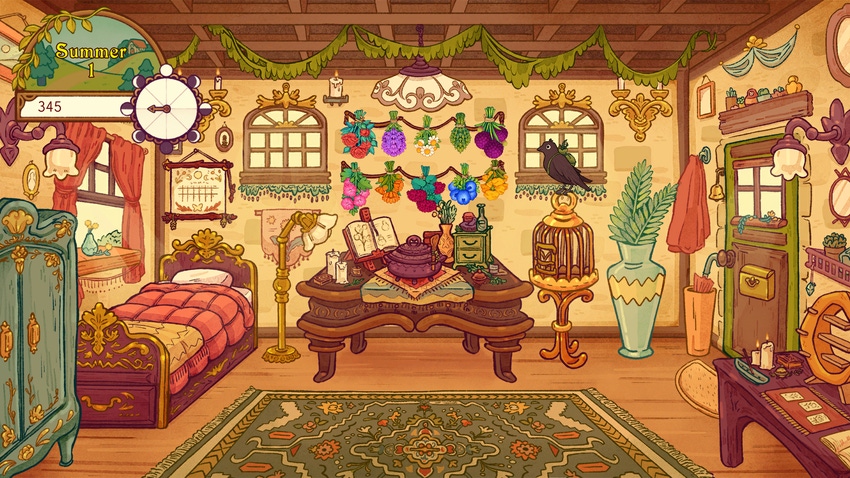Character creators are more important than ever: An interview with the team of Witchy Life Story
In the first part of our interview, the developers explain why character creators are integral to building a diverse audience.

Video games profoundly benefit from the player’s relationship with the avatar. As an in-game representation of self that facilitates identity, participation, and self-expression, there are few art forms that foster such a direct relationship between artist and audience. In the past several years, as the desire for diverse representation in games has grown, character creators have helped meet the demand, offering a mix-and-match set of visual traits through which the player can make a protagonist of their own choosing, like a game of virtual paper dolls.
One developer making this value a foundation of their game’s design is Allie Ast, founder and creative director of Sundew Studios. Her latest project, Witchy Life Story, is a visual novel that combines elements of dating and crafting sims, with players customizing their avatar from over two dozen options that include everything from pronouns to body type. For Ast and her team, making a game with a diverse character creator wasn’t just a cute way to expand upon the game’s folksy, 70’s-inspired art style. It was also a means to make something they themselves wanted to play, a game that reflected their shared desire to see themselves in the virtual worlds they live in.
The Game You Wish To See Yourself In
“Being a woman, a lot of the time the only time we get to play as women in games, even still, is if you can choose the gender of your character,” Ast tells Game Developer via video chat. Witchy Life Story, she says, had originally been conceived as a Stardew Valley-type farming simulator, but later gave way to more of a narrative-driven format, taking visual inspiration from the folksy plant and witchcraft subcultures on platforms like Instagram. It was also a product of her love for playing dress-up in Barbie games and fashion titles like Love Nikki Dress Up Queen, vehicles that allowed her to explore her developing sense of self. Self-expression, she discovered, was an important component of her experience as a player, and one that she wanted to pass on to her own audience.
Joining her in this vision are programmer Aubrey Scott and artists Sara Hagstom and Lianne Pflug. Scott, who first met Ast during GDC 2019, herself has a niche interest in character creators, influenced in part by the impact they’ve had on her personal identity. “To me, character creators were always a way to put myself into games before I even knew that I was trans,” explains Scott. “I would create girls and women characters to play as my avatars and there was a level of comfort that allowed me to explore my gender even before I knew why I was doing it.” This experience not only gave Scott insight into the importance of diverse character creators, but also informed how certain identity aspects would be represented within Witchy Life Story.

The witches of Witchy Life Story showcase the diversity of the character options.
Amid a greater cultural shift that has increased demand for diversity in games, character creators play a valuable role. They broaden the appeal and expand the audience for games by making them more accessible and technically feasible to include more people. But they also introduce new technical and social challenges. This makes Witchy Life Story, whose character creator has 27 different options across six categories, a vital case study of balancing these competing logistical constraints. Not only were time limits a factor, but there were also the finer points of certain cultural issues, such as the visibility of disabled characters, or the appropriation of cultural identifiers, to contend with.
“You're always afraid you're gonna be the person who's like, 'oh, women are just too hard to animate.' Like, I'm terrified of being that person,” says Ast. But she says that some things got left on the cutting floor in the interest of resources. As a visual novel, they were already at an advantage in terms of reduced workload; with stationary images rather than animations, it was a lot easier to fit extra details in. But some assets required such radical visual transformation that it involved too much work for the studio’s small team.
Wheelchairs, for example, could not realistically be added due to the number of illustrations that would have to be redrawn to accommodate them. Scoping the game came with an awareness of the limitations of being the game’s sole designer. “It’s never fun,” she says of trying to balance the workload while retaining the most features. “But you kind of have to tell yourself—especially when you're making character creators, and your goal is to represent as many people as possible—to get as far as you can with this game, and then the next game because you already have all this tech in place, you can push it a bit further.”

“An inclusive character creator leaves space for players to make that decision for themselves without judgment or expectation from us as developers.” --Scott
There was also a strong desire to avoid stereotyping, which meant that some aspects of player identity rely on an ecosystem of self-expression options to represent them. None of the features, like romance or clothing options, are locked to gender or sexual identity; in fact, there is no option to choose sex or gender at all. Says Scott, “It is important for diversity to not limit the choices based on other choices you make about the character.” To her, this is a choice that actually supports the player’s self-expression rather than limiting it. “We tried to have players only make explicit choices about things that may come up in the story and gameplay. There are lots of options for gender expression, as that shows in your outfit choices, body types, accessories, and such. Pronouns definitely existed because other characters and even the main character may use them at times. But we don’t make players pick a sexuality as that is usually personal and can be expressed through gameplay better than chosen from a list of options.”
Certain conflicts arose by keeping the character creator unrestricted, which answered some of the game’s more philosophical questions but created other problems. Ast says there was uncertainty over allowing the player full freedom of choice, in that it would inevitably lead to certain cultural faux pas, for example, a white character using the dreads hairstyle. “But,” she adds, “I think you can only control so much. We [decided to] let people do and hope they choose wisely.”

“Diverse character creators make it so that everyone feels seen, considered, and comfortable.” --Hagstrom
Ultimately, the choice to diversify the game’s character creator came from a personal place, but also an awareness of what players want and need. Scott, who describes the audience response to the game as generally warm, says that when making character creators, the most important thing is that players feel comfortable, which means listening to and, when possible, incorporating feedback. “I think the biggest thing from player feedback is understanding what landed and what needs more work. The players are ultimately the ones who really need to feel comfortable with our choices, so their feedback definitely shapes the choices we make in future games and sometimes future updates, given that there is enough budget for continued development.”
In part two of our interview with the Witchy Life Story team, programmer Aubrey Scott and artist Sara Hagstrom go into more technical depth about the character creator, in terms of how they developed its visual cohesion while making the process fluid and time efficient. In it, they detail the process of layering the separate components of the creator’s character options, how the facial expression and body type features were implemented, and how to design for freedom of expression, among many other topics. Click here to read the full Q&A..
About the Author(s)
You May Also Like









